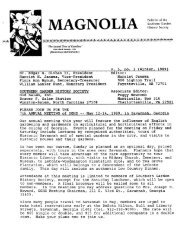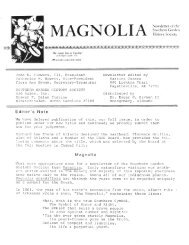Magnolia Newsletter Fall 04 - Southern Garden History Society
Magnolia Newsletter Fall 04 - Southern Garden History Society
Magnolia Newsletter Fall 04 - Southern Garden History Society
Create successful ePaper yourself
Turn your PDF publications into a flip-book with our unique Google optimized e-Paper software.
Appendix<br />
[Transcribed from Xerox copies of microfilm of: San Antonio Express, September 2, 1934, <strong>Society</strong> page<br />
feature story, Center for American <strong>History</strong> collection]<br />
In Grandmother’s Old <strong>Garden</strong> Where the<br />
Rose Reigned as Queen<br />
[Inserted here were pictures with the following captions: A <strong>Garden</strong> Nook,<br />
The Old DeZavala Home, a Nook to Rest In, Bancroft in His Prime,<br />
Home of George Bancroft the Historian at Newport, R. I., Where Mrs.<br />
DeZavala is Buried, Mrs. Lorenzo DeZavala.]<br />
“Early Texas Pioneers Found Solace in the Beauty of Nature’s Blooms,<br />
and Modern Folk Might Do as Well So Adina DeZavala Thinks”—<br />
By Adina De Zavala<br />
I was asked to tell about the roses which grew in my<br />
grandmother’s garden down to 1846. Of course it is not possible for me<br />
to tell of these roses of my own knowledge at that period, but I decided<br />
to do the best I could and tell of the rose plants and flowers that had<br />
been brought down or still survived of the old garden to my childhood<br />
days and also to avail myself of the knowledge of the generation ahead<br />
of me who were eye witnesses and had had first hand information.<br />
We know from old letters, diaries and reminiscences of old settlers,<br />
that many of them brought seeds, cuttings and plants whence they came<br />
and friends and relatives sent them others when occasion offered, and<br />
that they exchanged seeds and plants with friends and neighbors. Some<br />
of these died and some thrived. I have read a letter dated in the late<br />
sixties, I think, in which the writer offered to send fruit trees from New<br />
York to his relative.<br />
The subject of my grandmother’s garden brought up lovely visions<br />
of the past and a long train of memories that were almost submerged<br />
and of which I would never have thought again, except for this request.<br />
As I gazed back in memory on my grandmother’s garden, my first<br />
picture was of a beautiful Althea which stood on the right of the gate as<br />
one entered—and not far from the house. I loved it—it seemed always<br />
in bloom, and the tree symmetrical and perfect. The flowers were<br />
delicate pink, double, almost like a rose—in fact—it was thought by<br />
many of the unknowing in flower lore, to be a tree of roses, it was so<br />
beautiful.<br />
The house faced south, and on the right or east side of the small<br />
veranda, was a yellow climber, the Yellow Banksia, on the left or west<br />
side was a dark, crimson double cupped climber, Cramoisi Superieur. It<br />
appeared to be a continuous bloomer.<br />
A small passage on the east side of the house led down to a lot to<br />
the north on which was a quaint “story and a half” house belonging to<br />
grandmother in which the writer and poetess, Mollie E. Moore (Davis)<br />
lived. This passage was lined with roses of every hue, form, and<br />
fragrance. The Roses of Provence are well remembered for the way the<br />
leaves wrapped about one another, and for this reason they were called<br />
Cabbage Roses.<br />
Bancroft’s Hobby<br />
George Bancroft, afterward to become America’s great and noted<br />
historian, was my uncle’s tutor. He was then writing his history of the<br />
United States, and his chief relaxation was planting and tending roses<br />
which he ardently loved. There is a tradition that my grandmother’s<br />
garden had roses of his selection. When he was about to start his school<br />
Bancroft wrote to S. A. Eliot (as Bassett in his American <strong>History</strong>, page<br />
146 says:) “We intend going into the country. We shall choose a<br />
pleasant site where nature in her loveliness may breathe calmness and<br />
inspire purity. We shall train up a few minds to virtue and honor, and<br />
hope that when we die there will be some hands to throw flowers over<br />
our tombs.” His rose garden which became so famous was that at his<br />
magnificent estate at Newport, R. I. It was said this rose garden had no<br />
rival in the United States, in its earliest days, and that his tea roses were<br />
especially beautiful.<br />
Then, too, grandmother often spoke of the beautiful gardens in<br />
France, which she much admired when she was at the Court of St.<br />
Cloud, as the wife of an ambassador plenipotentiary (Texas was a part<br />
of Mexico at this time). I believe that the crimson Gloire des<br />
Rosomanes, the Louis Phillippe, the rosy flesh colored Madame<br />
Bosanquet, and perhaps others, came from the gardens of St. Cloud.<br />
In the southwest corner of grandmother’s yard was a lovely<br />
magnolia. On the snowy surface of its flowers’ broad white petals my<br />
elder playmates wrote names, valentines, and notes. Many, strangers to<br />
this lovely flower, do not know that messages written with a pin or<br />
other sharp pointed instrument on the magnolia’s petals or leaves turn<br />
dark brown, and may be easily read. The leaf, of course, is not as perfect<br />
a tablet as the white petal. To the children of that by-gone era, in<br />
playing, the stamens of the flower—wax-like, with red tips—made<br />
mock illuminating matches, and the leaves shaped into wonderful<br />
drinking cups; and the scarlet seeds made a pretty and glowing necklace.<br />
My sister and I have lately used the magnolia for place cards, just as a<br />
reminder of the old days and old time traditions. Sam Houston is said<br />
to have sent social notes from the battlefield of San Jacinto after the<br />
battle, on the magnolia petals, and Mrs. Mary Jane Harris Briscoe of<br />
Harrisburg and Houston, widow of Capt. Andrew Briscoe, told us that<br />
Sam Houston often used the white petals for visiting cards. Some of the<br />
early settlers had preserved these unique souvenirs—then yellow with<br />
age. Just today, I have received some verses on “The <strong>Magnolia</strong>” written<br />
on three magnolia leaves by one to whom we had lately told the story of<br />
Gen. Sam Houston’s use of the magnolia petals as tablets.<br />
In an Old <strong>Garden</strong><br />
In the front of this yard were moss and tea roses of different colors<br />
and delightful perfume. Outlining the beds were violets, pansies, forgetme-nots<br />
and Johnny-jump-ups. Along the fence were pinks, verbenas<br />
and geraniums of many kinds and colors, and beautiful pink Texas stars<br />
(I have never seen any of the latter since). There were also lady slippers<br />
(moccasin flowers) and larkspur. In the southeast corner was a cape<br />
jasmine—quite a large bush with beautiful white blooms.<br />
On the west side, north of the <strong>Magnolia</strong>, was a long bed of Flower<br />
de Louis—not Fleur de Lis—Louis VII named them after himself<br />
–“Fleur de Loys.” Ruskin says, that the “Flower de Luce is the flower of<br />
chivalry with a sword for its leaf, and a lily for its heart.” A utilitarian<br />
and more prosaic writer says, “Its root is good for a bruise.” Further<br />
along on the west side were Cox Combs, Bachelor Buttons, Old Maids<br />
(Zenias) Touch-Me-Nots, (Sensitive plants) Hollyhocks, Marigolds,<br />
etc., and then came a bed of sweet scented herbs of various kinds, and<br />
in the northwest corner, a rose bower.<br />
8 <strong>Magnolia</strong> • <strong>Fall</strong> 20<strong>04</strong> Vol. XIX, No. 3
















